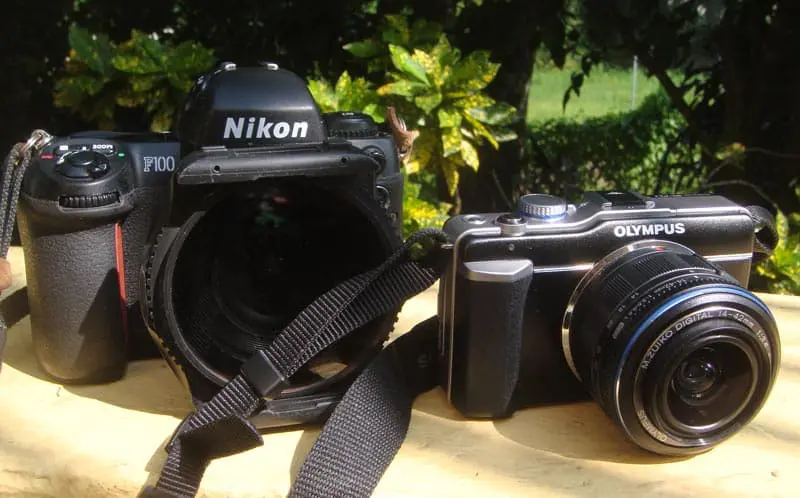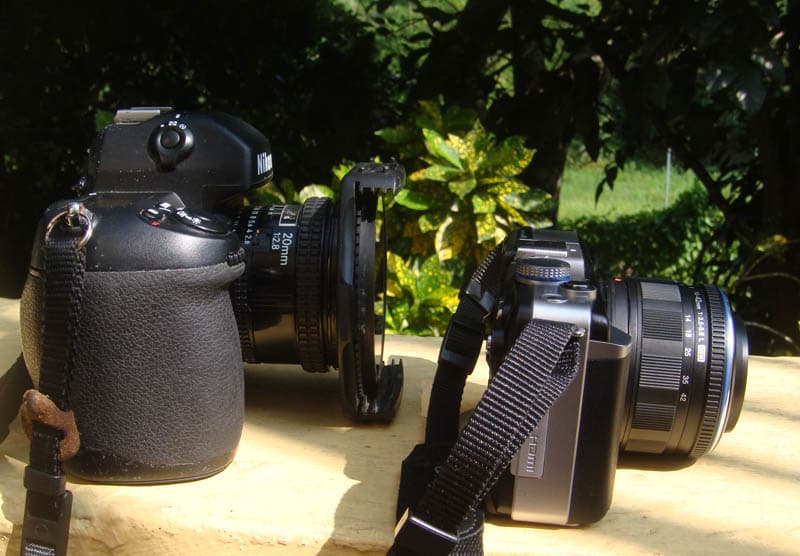An overview of the micro-four thirds mirrorless camera system.
I chose micro four thirds partly after learning of it through interest in video: I saw Panasonic had a professional micro four thirds camera coming out, the AF100 (also known as AF105). Reading about micro four thirds, I found this is a new system, mainly from Panasonic and Olympus, but with other manufacturers on board. Fully digital, including lenses designed for optimum performance with digital sensors, and set for expansion.
Four thirds sensors
Uses “four thirds” sensors, which are 4/3 inch along diagonals – somewhat smaller than many DSLR sensors, a good deal smaller than the pricey “full frame” (around 35mm size) sensors, but eight to nine times larger than sensors in compact digital cameras. This means a decent megapixel count, but more importantly each pixel can be better quality than for small sensors – better dynamic range (so better tones), and significantly less noise. As well as enhanced tones, the sensors ensure significantly improved performance in lower light – I’ve read that the Olympus E-PL1 noise levels are good to 1600ASA. Improvements since, including the E-P3 and OM-D 5.
These four thirds sensors are already in use in larger, four thirds DSLR cameras from Olympus and Panasonic.
For a good deal more info, not specific to four thirds, see Digital Camera Sensor Sizes. Also Four Thirds Sensor Size and Aspect Ratio, which knocks notions the sensors are significantly smaller than and so will significantly underperform regular Canon and Nikon DSLR sensors: “The most common types of DSLR sensors (APS-C and Four Thirds) have practically the same size; therefore any discussions of differences between them due to the size are groundless and just demonstrate that someone did not bother to check the numbers”
Full sensors in smaller cameras
The “micro” refers to camera sizes. Though they are akin to DSLRs, as they have interchangeable lenses, the cameras lack elements such as the mirror that sends light to viewfinders in DSLRs, and this makes them considerably slimmer and lighter. This in turn means photos are composed using only digital screens, perhaps within add-on viewfinders. Also, focusing relies on the sensor, which can be somewhat slower than for a DSLR (I was aware of and ready for this with the Olympus, but find focusing generally fast).


Compare the sizes of Nikon F100 (a film camera, but similar to DSLRs) and the Olympus E-PL1.
Small lenses too
Lens mounts are also rather smaller, and lenses are likewise smaller than for regular cameras. They include “pancake” prime lenses, which are very slim, and wide angle – such as 14mm (28mm). Olympus has come up with a 75-300mm zoom, billed as the world’s smallest 600mm lens
As the sensors are not full frame, lenses are more “powerful” than they would be on a 35mm camera; with micro four thirds, they are 2x stronger. So, for instance, a 50mm lens delivers a performance equivalent to a 100mm lens.
Micro four thirds lenses can be swapped between cameras in this system (though maybe the 3D lens from Panasonic only works with certain models).
It’s also possible to mount other lenses, such as regular four thirds lenses.
So far, I am very happy with the choice: the camera is versatile, and small and light enough to be carried around pretty much anywhere – albeit just a bit large for my trouser pockets (and would remain so even if I swapped the zoom “kit” lens it came with for a pancake lens).
